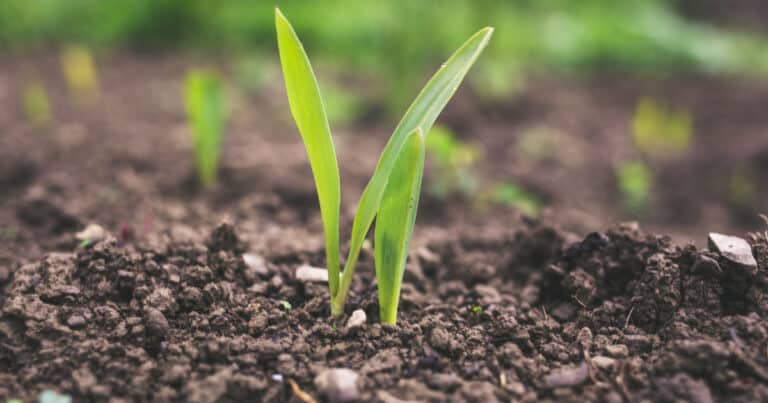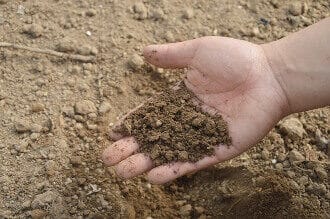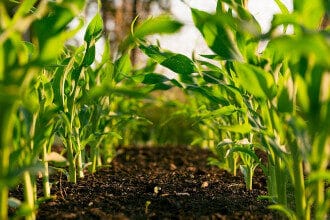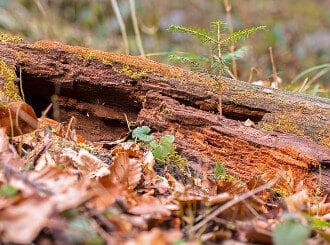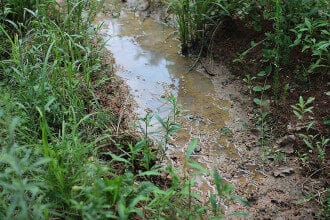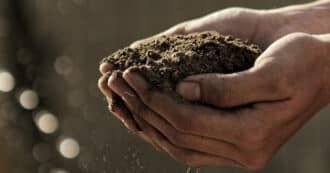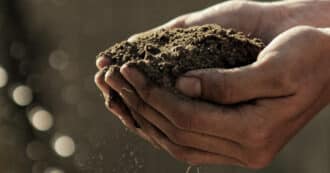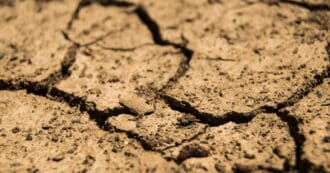By Harry Cooper – Many people may think of soil as nothing more than the dirt beneath our feet, but the reality of soil science is much more complex than that. Read on to discover how soil serves our lives!
What is Soil?
Put simply, soil is the top most layer of the Earth’s crust that is comprised of organic matter, minerals, air, and water. While this may seem like a simple recipe, soil is a dynamic and important part of the natural world that comes in many different varieties, all with different physical, chemical and biological properties.
Soil formation consists of its basic ingredients binding and cementing together to form larger soil particles called aggregates. The content of these aggregates and the way they’re arranged impact their structure, texture, and overall soil properties. The specifics of what makes up differing soil types and how it’s formed determines its soil fertility, soil health, and soil quality.
Soil Properties
Soil texture is determined by how large or small soil aggregates are. Larger particles will create a sandier texture while smaller ones create a more clay like texture. Soil textures are important for determining how well soil can retain and transfer water and air, with sandier soils typically having better retention, resulting in more productive soils.
Another important soil property is its organic matter content. Soil organic matter usually makes up less than 10% of soil content, but nonetheless it is incredibly important for soil function. Soil biota comes from decomposing organic matter, such as plant roots, as well as a variety of microscopic soil organisms including bacteria and fungi. A higher organic matter content means a more nutrient rich soil, as well as it being more capable of decomposing other organic matter.
Important Soil Functions
The physical and chemical properties of soil are crucial to enable soil to best achieve its key functions. Soil scientists outline these three ecological functions for soil as the most important soil functions.
Soil Function of Plant Growth
Soil is required for every plant on Earth to grow. Soil acts as a place for plants to put their roots, but soils with lots of stored nutrients and water also provide plants with the sustenance they need to thrive and grow. Soils with more organic matter and more capacity to hold water create an optimal environment for plant growth. This is why soil quality is incredibly important for agricultural productivity, maintaining biodiversity, and plant life everywhere.
Soil Function of Nutrient Cycling
The process of soil taking up nutrients from decomposing organic material and transferring them into plants and the water and air around them is very important to many different nutrient cycles. This helps distribute nutrients such as nitrogen and phosphorus across a variety of species and ecosystems, but one of the most important nutrients to be taken up by soil is carbon.
The storage of soil organic carbon is an important tool in the fight against climate change. As plants photosynthesize they take carbon dioxide out of the air. This carbon would normally be put back into the atmosphere when the plant dies and decomposes, but as soil takes up the carbon from the dying plants, it stores it away long term and prevents it from returning to the atmosphere. This sequestration of carbon effectively removes greenhouse gases from the atmosphere, contributing to reducing global climate change.
Soil Function of Water Quality Regulation
Healthy soil, with high soil porosity, is capable of storing water and transferring it into surface bodies of water and groundwater stores. This is a very important part of the water cycle as healthy soil helps to filter out dissolved materials, silt particles and other pollutants in the water. This is another reason why it is important to maintain the physical properties and the chemical properties of soil as a healthy soil structure is capable of retaining and transferring water, whereas poorly managed soil can lead to erosion and sedimentation.
Soil Functions and Religion
Leviticus 25:4 – But in the seventh year the land shall have a sabbath of complete rest, a sabbath of the Lord: You shall not sow your field or prune your vineyard.
Let the Land Rest by Rabbi Noam Yehuda Sendor, Eco Bible Volume 2
Before the sin of Adam and Eve, the earth provided sustenance not through the plotting and plowing of people but rather through prayer. In the Talmud, the sage Rav Assi (3rd century CE) expounds that vegetation would not break through the earth until Adam came and prayed to God to have mercy on the earth. The rains fell, and the earth sprouted.
We can interpret the removal of the fruit from the Tree of Knowledge of Good and Evil as a decision to derive pleasure from God’s earth without paying attention to consequences. As a result, humankind’s working of the land was no longer within the context of safeguarding it. Thus, the earth became cursed, sprouting thorns and thistles, only giving forth its fruit by the sweat of one’s brow. The commandment of the Sabbatical year enables a return to the ideal relationship between humankind and creation. The laws and rulings relating to the Sabbatical year are numerous and complex, yet they derive from four general commandments in the Torah:
- The land should rest, as it says: “ . . . and the land shall rest a sabbath to God.” Though this commandment is directed at the land, it is humanity’s responsibility to return all of creation to a proper relationship with God. By refraining from planting, pruning, plowing, harvesting, or any other form of working the land, the land is allowed to rest and move toward achieving the union of Shabbat.
- All seventh-year produce is declared ownerless and free for all to take and enjoy.
- All seventh-year produce is sanctified. The Torah prohibits any business whatsoever with the produce and obligates that it is consumed properly and equitably and does not go to waste.
- All unrepaid loans that have come to the end of their term are to be canceled.
The mandated abstinence from attempting to control the land and own its produce frees us from the enslavement of the constant pursuit of material goods and wealth and the idolatrous illusion that they make up our existence.
Additionally, the Sabbatical year provides ample time to contemplate and understand that it is not through the strength or the might of our hand that the earth brings forth its fruits. This both instills a deeper sense of faith and trust in God and allows a shift in how we relate to the earth. We must view the earth as a precious gift that has been entrusted to us. We must treat it in a caring and sustainable manner.
The inner teachings of the commandment of the Sabbatical year are vital today as humankind flirts dangerously with destroying the beautiful world we have been given. One example is the deforestation of vast portions of earth’s most vital ecosystems to support the growing demand for beef. The “slash-and-burn” method of clearing land for agriculture, employed globally by both small- and large-scale cattle farmers, involves cutting the vegetation of a plot of land and allowing it to dry, at which point it is burned. The land is then cultivated for a few seasons before being used for cattle pasture. Though this process releases nutrients to fertilize the soil, it is only sustainable on a small scale on nutrient-rich soil. When applied on an industrial level to nutrient-poor soil – as with the current situation in the Amazon rainforest –the result is an ecological disaster.
As author Richard Robbins puts it: “Hundreds of thousands of acres of tropical forests in Brazil, Guatemala, Costa Rica, and Honduras, to name just a few countries, have been leveled to create pasture for cattle. Since most of the forest is cleared by burning, the extension of cattle pasture also creates CO2, and . . . contributes significantly to global warming.” Such operations lead to erosion and remove most of the nutrients from the soil, leaving it desolate. The result is severe damage to the biodiversity of the rainforest, an increase in the release of CO2, and general biosphere instability. Instead of being elevated and sanctified, the earth has become trampled and disgraced. The frightening ecological reality we are facing morally obligates us to rethink our relationship with the land and the consequences of our actions.
* Featured image source

